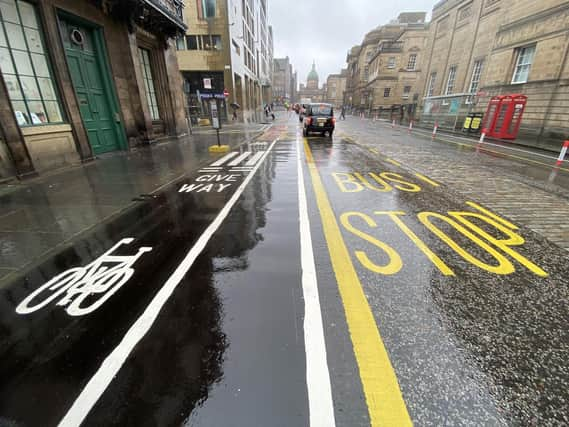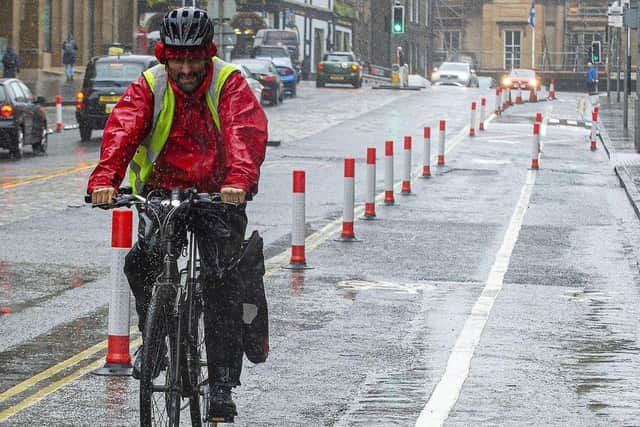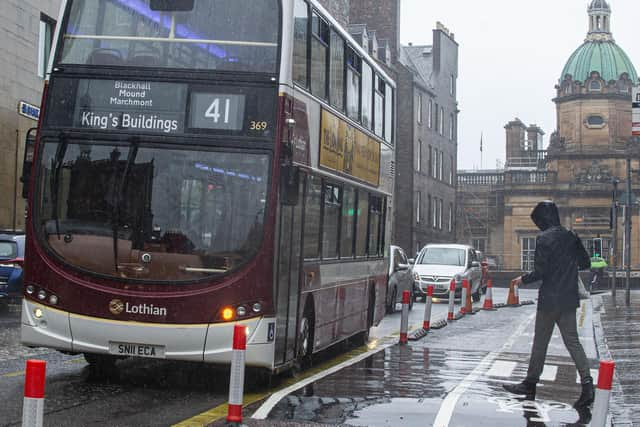Spaces for People – what has gone right and wrong with the controversial scheme?


In May 2020 the Scottish government announced funding for Spaces for People programmes, which aimed to provide safe options for essential journeys during the coronavirus pandemic.
Since April of that year, Edinburgh City Council has used the £5m it received from the Scottish government to introduce 29 road closures, 39km of segregated cycle lanes and 54 measures to reduce the risk of infection near school gates including pavement widening, new gates and one-way systems for pedestrian access.
Advertisement
Hide AdAdvertisement
Hide AdSome of these Spaces for People (SfP) measures have proved incredibly controversial, with several sparking community campaigns against them.


Other measures, particularly in areas that experience serious traffic congestion or speeding, have been broadly welcomed by residents.
Why was it installed?
The measures were introduced as a response to the Covid-19 pandemic, to allow Edinburgh residents to walk, wheel and cycle on the capital’s roads while maintaining social distancing.
Previous layouts, particularly of pedestrian pavements, made this impossible.


Advertisement
Hide AdAdvertisement
Hide AdPublic health advice still requires physical distancing to be maintained and SfP measures remain in place for that reason.
How long will SfP measures stay in place?
Some may become permanent, others are set to disappear shortly, and some may be around for another 18 months – it all depends on the outcome of the council’s own reviews, a city-wide consultation and market research which will inform councillors sitting on the Transport and Environment Committee, where final decisions will be made.
The timescale for each scheme depends on when they were installed. The first Spaces for People measures were introduced using Temporary Traffic Regulation Orders (TTROs) which council officers say are used to reduce ‘specific risks’ to the public – in this case the transmission of the coronavirus.
These powers allowed the council to install SfP measures without prior consultation for up to 18 months.
Advertisement
Hide AdAdvertisement
Hide AdNow, as we approach the end of the 18 month period for the majority of the schemes, the council is set to add on another 18 month ‘temporary’ period by switching to Experimental Traffic Regulation Orders (ETROs).
The ETROs will be used as an ‘experimenting and learning’ exercise over the next 18 months – meaning some Spaces for People schemes will have been in place three years before going through a formal legislative process.
The council says it is switching to ETROs, rather than the usual legal process where formal objections can be lodged by residents, because during the pandemic traffic and public transport levels have been incredibly low, and still haven’t recovered to pre-pandemic levels.
Which SfP measures are set to be retained using ETROs, and which will be removed?
Advertisement
Hide AdAdvertisement
Hide AdSome of the key recommendations for measures, once they are no longer required to maintain physical distancing, include:
Schools –
• Retaining road closures outside Sciennes and James Gillespie’s Primary Schools• Work with the many other schools which have had part time vehicle prohibitions with a view to bringing forward proposals for new school streets or, in a few cases, road closures, to replace temporary measures by the end of 2021
City centre projects –
• Retain pedestrianisation on Victoria Street, Cockburn Street and Waverley Bridge• Remove the measures on George IV Bridge and Forrest Road, while retaining the uphill segregated cycle lane on The Mound
Shopping streets –
• Remove most of the measures on shopping streets, though give consideration to retaining some small lengths of footway widening, in particular where the existing pavement doesn’t provide enough space for people to walk• Retain the measures introduced on Queensferry High Street
Protected cycle lanes –
Advertisement
Hide AdAdvertisement
Hide Ad• Retain all protected cycle lanes, including on Crewe Road South, Comiston Road, Lanark Road, Fountainbridge/Dundee Street, Silverknowes Parkway, Ferry Road, Willowbrae Road, Old Dalkeith Road and others.• Carefully review schemes during the development of the ETRO to minimise the impacts on disabled street users, also considering adjustments to loading restrictions and to ‘floating’ car parking• Consider amendments to benefit bus services
Connecting routes for exercise and cycling and walking for pleasure –
• Retain measures including the closure of Braid Road to northbound traffic, the closure of Cammo Road to motor vehicles and the Meadows to Greenbank Quiet Connection• Retain measures on Silverknowes Road North, Silverknowes Road South and connecting streets, forming a connection to Silverknowes promenade• Remove closure of Links Gardens, though consider reinstatement as part of proposals for a Leith Low Traffic Neighbourhood.
Why has SfP provoked so much opposition?
As in most debates, the most extreme voices shout the loudest, and some people see SfP as a culture war between cyclists, who supposedly want to ban cars from the road – and motorists who supposedly don’t like being stuck behind bikes and who don’t want to be inconvenienced by change.
Advertisement
Hide AdAdvertisement
Hide AdThe reality is somewhere in the middle, and the cultural aspect of the two camps has been somewhat exaggerated and weaponised by some of the city’s more enterprising politicians.
The council is battling both air pollution in the city centre and an ambitious target to be ‘net-zero’ by 2030, but is also conscious the city’s economy is on its knees.
Councillors in the ruling SNP/Labour administration believe the city can recover from the economic effects of the coronavirus and tackle climate change by providing residents with the opportunity to use more modern, greener approaches to transport.
Councillor Lesley Macinnes, the council’s transport convener, says SfP is about giving residents a choice – only 45% of Edinburgh residents have access to a car – but critics say the council is using the stick more than it is using the carrot.
Advertisement
Hide AdAdvertisement
Hide AdFor example, most of the criticism stems from the way the schemes were implemented. As explained above – by using TTROs, and latterly ETROs, rather than the usual legal mechanism for changing road layouts, the council was able to install SfP schemes without first consulting with residents.
This has led to claims the council has installed measures that are unwanted by local residents, and even that the council has used the coronavirus pandemic as an excuse to pursue its plans for greater walking and cycling facilities.
Road closures have also closed off some of the capital’s rat runs – meaning some drivers have faced slightly longer commutes while reducing through-traffic in neighbourhoods.
Some of the new schemes have also appeared nonsensical, and counterintuitive – one such example is the notorious ‘floating bus stops’, where bus stops are situated in between a cycle lane and the road, which critics say put pedestrians at risk.
Advertisement
Hide AdAdvertisement
Hide AdThere are also floating parking spaces, where parking spaces have been taken away from the curb to make room for a cycle lane, giving the appearance that the parking spaces are actually in the road.
The council says it has consulted with several organisations, and changed the schemes accordingly.
It has also undertaken a city-wide consultation and commissioned market research on the scheme as a whole.
What consultation has taken place?
The council did not consult before implementing the SfP measures, however, ahead of switching from TTROs to ETROs (see above – How long will SfP measures stay in place?) the council undertook a city-wide consultation.
Advertisement
Hide AdAdvertisement
Hide AdThe council’s consultation on retaining Space for People measures ran for an initial four-week period, later extended to six weeks to allow more people to give their views.
There were three surveys, one for individuals, for businesses, and for stakeholders. In addition, there were six stakeholder presentation sessions in advance of the consultation opening: heritage, emergency services, accessibility, business, active travel and bus operator.
A range of approaches were employed to help ensure as wide-ranging and inclusive consultation exercise as possible, given that this took place during a period of lockdown.
To ensure accessibility for a wide range of people, the consultation was made available in a range of formats such as regular print, large print, braille and translation into other languages.
Advertisement
Hide AdAdvertisement
Hide AdA British Sign Language video was also displayed on the project website to further widen access to people with hearing loss.
The consultation was advertised across social media and radio to reach people at home, given the large number of people working at home and on electronic devices. To reach people while making essential journeys, lamp post and bus shelters adverts were installed outside supermarkets and in shopping streets, parks and on public transport corridors.
All wards in Edinburgh had wraps and/or bus shelter adverts installed to ensure city-wide coverage.
In total over 17,000 responses were submitted, one of the largest responses to a consultation in the city.
How has it impacted on disabled people?
Advertisement
Hide AdAdvertisement
Hide AdDisabled Edinburgh residents have expressed ‘serious concerns’ about SfP – particularly over ‘floating’ bus stops and a lack of blue badge parking provision.
Their concerns have been raised by the Edinburgh Access Panel (EAP), a partnership of disabled people and disability organisations that works with the council and local businesses ‘to improve accessibility for physically disabled and sensory impaired people, predominantly in relation to the built environment’.
Robin Wickes, the EAP’s vice chairman, says the group has reviewed and commented on more than 100 proposed measures since last May.
Mr Wickes said: “The main issues they have commented on are to do with the new cycle lanes that have popped up all across the city.
Advertisement
Hide AdAdvertisement
Hide Ad“Because they are worried about the risk of pedestrians – particularly people with mobility difficulties – being injured in collisions with cyclists, they have objected to road layouts where pedestrians have to cross a cycle lane to get to their bus, for example on George IV Bridge, or to their parked car, for example on Comiston Road.
“The panel’s other major concern is that access and parking for Edinburgh’s 6500 disabled blue badge holders is being made much more difficult because blue badge parking is prohibited on the new cycle lanes.
“For many blue badge users their only option for getting about is to use their car.
“The 25 miles of cycle lanes that the council are creating are a major barrier for them because the cycle lanes prevent them from parking close enough to their destinations.
Advertisement
Hide AdAdvertisement
Hide Ad“Although we support the council’s objective of motivating people to cycle where possible instead of using their cars, it’s essential to make sure that promoting cycling does not have an unacceptable impact on disabled people.”
An Edinburgh City Council report reads: “We have engaged with a range of organisations who advocate for people with disabilities, including the Edinburgh Access Panel, RNIB and the National Federation of the Blind.
“This included notification of proposed schemes for comment before installation, leading to some changes in how schemes were implemented.
“For example, accessibility groups told us that temporary floating bus stops were a concern to them. In response to this, further temporary floating bus stops have not been introduced and any future use will be subject to further engagement with these groups to help devise a solution that works for everyone.
Advertisement
Hide AdAdvertisement
Hide Ad“Groups representing people with disabilities, and affected individuals and households, have also expressed concern about loss of car parking and about ‘floating’ car parking (where a cycle lane is between parking and the kerb).
“We have made a number of adjustments to projects as a result of this feedback, including increasing the space between parking and the cycle lane and installing SLOW markings on the cycle lanes.
“We will continue to keep these measures under review, with a view to making modifications to address continuing sources of concern.”
Who is paying for this?
Spaces for People measures have been financed via ‘ring-fenced’ grant funding from the Scottish Government.
Advertisement
Hide AdAdvertisement
Hide AdThis funding was specifically earmarked for projects to address the Covid-19 pandemic and large-scale use of the funding to supplement normal road maintenance would not have been permitted.
To date more than £5m has been invested across the city, helping to deliver a range of projects that have made it safer to get around during the Covid-19 pandemic.
The projects and associated consultation have not required any funding from the council’sbudget.
The council’s capital roads programme continues to make carriageway improvements across the city, with over £20m scheduled to be invested in 2021/22.
Comment Guidelines
National World encourages reader discussion on our stories. User feedback, insights and back-and-forth exchanges add a rich layer of context to reporting. Please review our Community Guidelines before commenting.